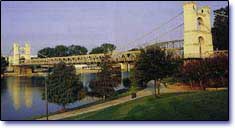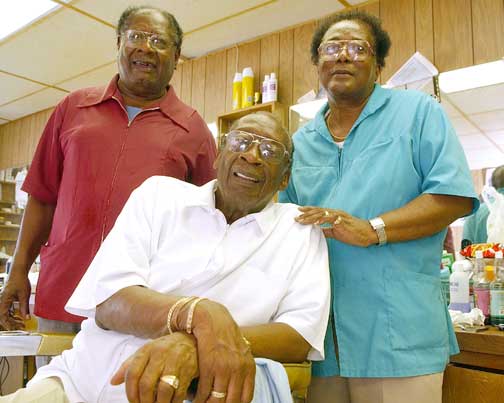

Places in Time

Bridge Street oral histories
From Bridge Street to the Square
By J.B. Smith, Waco Tribune-HeraldSept. 22, 2005
Before the big tornado, before the bulldozers of Urban Renewal, before the Hilton and the Convention Center, the area around the western end of the Suspension Bridge was a beachhead for minority-owned business.
In the early 1950s, blacks could catch a movie at the Gem Theater on the south side of the Waco Square without the indignity of segregated seating. They could go to a black dentist, Garry Radford, or get ice cream and prescriptions at the Mecca drugstore.
The area around Second and Bridge Street, which no longer exists on the west side of the river, boasted bars, grocery stores, barber shops, insurance agencies and restaurants owned by blacks, Hispanics and various immigrants.
The Jockey Club Barber Shop, which moved from the Bridge Street area to Elm Street in 1970, was part of the business district.
The barber shop started in 1917 at 131 S. Second Street, just southeast of the old square and now site of the Hilton parking lot. The shop weathered the 1953 tornado that demolished much of Bridge Street and the Square.
As they cut hair this week, barbers Cicero Martin, Jessie B. Mays and Lloyd Dugas fondly recalled the heyday of the old Bridge Street-square area.
Martin, 79, first saw it when he was 14, a boy living in rural Chilton. To him, the 30-mile trip to Waco was like “going overseas.”
"I'd never been in a place this big," he recalled. "My mom let me catch a ride on a truck that was taking people here for 50 cents. I was scared. I didn't hardly move from the truck because I didn't want it to leave without me."
He said he stopped at the Mecca drugstore for candy and ate lunch at "the Chinaman's," a Chinese-owned cafe where you could get red chili beans with bread and watery ketchup for 50 cents.
Back in the 1940s and '50s, Martin said, farm families would dress up and come into town on Saturdays to spend their hard-earned wages.
"All over the Square you'd see people from the country, from Downsville, Chilton, Satin, Marlin," he said.
The Rev. Rufus McClain, 92, who was getting a trim Wednesday at the Jockey Club, remembered cooking hamburgers at a grocery store near the Square as a young man.
"Around lunchtime I'd throw some onions on there and put a fan to blow that scent out on the street," McClain recalled. "And here they'd come."
By 1948, he would be working for Ben Frank Smith at the Jockey Club. He and Mays were in the shop with Smith on May 11, 1953, when the deadliest tornado in Texas history ripped east down Austin Avenue and smashed into Bridge Street. He remembers being huddled with the other men under a staircase while shards of glass blew through the building.
He also remembers Smith's short prayer: "Lord, help us."
"The Lord blessed us," McClain said.
The south and east sides of the Square, a hub of the black community as early as the 1880s, remained important even after the tornado. But in 1969, the federal Urban Renewal program cleared the entire Square area of some 200 buildings, sparing only City Hall. The Jockey Club got $2,500 in compensation for its move.
Martin said Urban Renewal was a loss for the black business community as well as for many black families that were displaced. He said it's important for the younger generation to know about that bygone era.